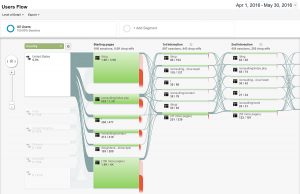— November 6, 2018

Why set agency revenue goals? Here are 10 benefits for 2019.
An agency owner asked for my advice on creating revenue goals for 2019, because “it feels like I’m just picking numbers out of the air without any real logic to them.”
From her question, I’ve created a 4-part article series on revenue planning for your agency, to help you make 2019 more proactive and less reactive.
If your annual revenue is over $ 1 million, you’re probably doing this already—but if you’re not, 2019 is the time to start!
Today is Part 1—we’ll talk about why you and your agency benefit from setting annual revenue goals. Understanding the 10 benefits will make the rest of the planning process easier for you.
Next week in Part 2, I’ll share how to set annual revenue goals. In two weeks in Part 3, I’ll cover how to turn those goals into a revenue plan. And in Part 4 on November 21st, I’ll share how to improve your chances of actually hitting your revenue goals in 2019.
Why to set agency revenue goals for 2019
Setting revenue goals helps you be proactive, rather than reactive. By taking time to plan for the expected, you’ll have time to improvise the unexpected—and it won’t be an emergency. (Or you’ll have fewer emergencies, at least.)
There are 10 benefits to setting revenue goals—which fit three categories. Here are the three categories:
- Capacity Planning (because you want to hire at the right time, upgrade your agency structure, and upgrade your internal processes before you hit crisis mode)
- Runway & Compensation Planning (because you want to know what you can pay yourself and your team, and you want to build “runway” to avoid or reduce mid-year financial crises)
- Growth Style Alignment (because you want to ensure you’re making intentional progress toward your long-term goals, whether it’s to sell or to build a sustainable lifestyle business)
Still on the fence?
But Basecamp said we shouldn’t set goals…
If you’ve read the excellent 2018 Basecamp book, It Doesn’t Have to Be Crazy at Work, you might be wondering if you even should set goals—because authors Jason Fried and David Heinemeier Hansson don’t, and they advise against company goal-setting.
I recommend the book, but I don’t recommend eliminating goals completely at your agency.
Why? As a SaaS firm, Basecamp has a predictable recurring revenue flow from its base of 2.8 million accounts. As a product firm, their staffing isn’t linearly related to their revenues—to a point, they can grow revenues without increasing their staff.
In contrast, agencies typically add staff to add (even more) revenue, unless they’re also developing their own products. The linear relationship means that a surge in staff had better match a [larger] surge in revenue—and a projected drop in revenue means you need to make difficult decisions about staff vs. sustainable profit margins.
Wish you could put your agency on auto-pilot? Setting revenue goals—including a revenue plan with monthly and quarterly targets—is even more important as you automate things. Part of the process includes setting “triggers” that something’s not working, as an “early warning” system. After all, pilots have greater safety margin when they restart a stalled jet engine at 30,000 feet than 3,000 feet.
All that said, Jason and David are right about a lot of things—including the unreasonable nature of many company goals. Don’t set unreasonable goals; done! (Well, mostly done.)
With that, let’s look more closely at the 10 benefits you can expect from setting revenue goals!
10 benefits to setting annual revenue goals
Agencies over $ 1 million in revenue tend to set revenue goals each year. If you’re not there yet, these points will give you a nudge to get to $ 1 million more smoothly. And if you’re over $ 1 million in revenue today, use this as inspiration to improve your revenue goal setting process.
Benefits from Capacity Planning
These benefits fall into three categories—hiring goals, agency structure, and process management.
1. Hire “Just Right”—instead of too early or too late.
Has it ever felt like you’ve hire too early or too late?
- When you hire too early, you’re paying people to do work you don’t need done, or work that could be handled by another resource. Worst-case, this leads to layoffs.
- When you hire too late, your team is overworked. This creates morale problems, and may lead to high employee turnover (more than 10-20% annually). You don’t want to lose your strong “New Rope” employees.
Capacity planning—thanks to setting revenue goals—can help you mitigate both problems, because you’re not guessing.
As a reminder, your per-capita revenue (technically “revenue per FTE”) is ideally at least US$ 150,000 a year. More is better—like $ 200K+. If you’re projecting less than $ 150K in revenue per FTE (especially if that figure is approaching $ 100K or less, which puts you at risk of going out of business), be careful not to over-hire. And if you’re projecting more than $ 150K, you can decide when it makes sense to hire.
2. Know when to upgrade your agency structure, including team structure.
You can’t scale without making the right agency structure changes as you grow. As you grow, you’ll make to make changes, including team structure.
For instance, agencies tend to hire their first PM when they’re between 8-12 employees, and they typically choose to hire a salesperson as they pass 15-20 employees.
You’ll likely also need additional Subject Matter Experts (SMEs) as you grow, too. As described above, capacity planning helps you understand when those hiring points might come.
3. Know when to upgrade your internal processes.
Knowing your future projected revenue also helps you flag problems in your internal processes—including PM, hiring, and client onboarding.
If you have aggressive growth goals (more than 30% a year), you’ll likely need to overhaul your approach to PM. What worked marginally last year will barely work this year, and it definitely won’t work next year. You’ll want to assign your operations head to figure out how to solve this, before it turns into emergency mode.
This applies to account management, too—for instance, if you’d need to onboard a number of new clients, you probably need to overhaul your client onboarding process. (For most agencies, I recommend targeting 10-20 active clients as your ideal client count.)
Benefits from Runway & Compensation Planning
The benefits fall into four categories—knowing if you’re on-track toward your annual goal, and seeing gaps while there’s still enough time to fix them, estimating your compensation as the owner, and identifying profit-sharing opportunities for your team.
4. Know whether you’re on track each month toward your annual goal.
It all adds up—if you aren’t regularly hitting your monthly goals, you likely won’t hit your annual goals.
As I share below, knowing where you stand creates extra motivation—if things look off track—or extra peace of mind—if things are on track.
5. See gaps when there’s still time to fix them.
When you manage against revenue goals, you’ll build “runway” to avoid mid-year financial crises—since you’ll know something’s a problem before it turns critical.
After all, it’s easier to fix problems when you still have time to make an impact.
6. Estimate your annual compensation as an agency owner.
You have personal financial goals—your financial planner can better advise you when s/he knows what you’re planning to make this year.
Your personal compensation ultimately stems from your agency’s overall budget—not revenue goals alone—but more money in and less money out typically means more compensation for you.
If revenue projections are down, you’ll know you’ll likely need to cut your compensation this year… and/or potentially lay off employees or make other cuts. Not fun, but better to know now, before you risk running out of cash or burning through your agency’s emergency fund.
7. Identify profit-sharing opps for the team.
Your revenue goals help you know what you can pay in profit-sharing, when you create a budget that combines the revenue goals with your planned expenses.
If numbers are down, you’ll ideally communicate that sooner than later. Disclosing this may lead to some people leaving—but if often helps you “enlist” current employees in overcoming the gap. And regardless, transparency is usually better than people learning bonuses are down… and wishing they’d known sooner.
Benefits from Growth Style Alignment
When it comes to revenue planning, Agency Growth Style benefits fall into four categories—measuring progress toward your long-term goals, assessing your overall business health, knowing whether it’s a growth vs. maintenance year, and creating extra motivation or peace of mind.
8. Measure progress toward your long-term goals, and assess your overall business health.
You want to ensure you’re making intentional progress toward your long-term goals, whether it’s to sell or to build a sustainable lifestyle business.
As I discuss in my article on Agency Growth Style, agency owners typically lean toward running either a Lifestyle-oriented agency (seek strong profits and above-market compensation) or an Equity-oriented agency (growing to sell or secure another exit).
As a fellow speaker shared at AgencyCon, businesses have one of three purposes—acquire other companies, get acquired, or run in perpetuity as a lifestyle business. Once you choose your preference, you want to ensure you’re still heading in that direction.
9. Know whether it’s a growth year vs. maintenance year.
Are you going to push for growth, or use the lower pressure to rebuild? Knowing that up front helps you make better decisions.
- It’s hard to do maintenance during a growth year—it’s like building the plane while flying the plane. Ideally, you’ll do the maintenance and process-building and other overhauls before the growth starts. (More on that in a future article.)
- Likewise, it’s risky to plan on maintenance if you actually do the maintenance. Otherwise, you might find yourself with reduced profits and no internal investments to show for it.
Either option is fine, if it serves your long-term goals—but don’t leave things to chance. Your financial security shouldn’t depend on “happy accidents.”
10. Create extra motivation—or extra peace of mind.
Without revenue goals and a revenue plan, you won’t know if you’re on track.
- If you’re on track, it creates peace of mind—and you can relax a little.
- If you’re not on track, it creates extra motivation to fix the problem—including rallying your team to help.
The same is true when it comes to your annual revenue plan—if you’re happy with low goals, you can relax a little; if you’re concerned about hitting big goals, you can prepare yourself for the “push” you’ll need to make, or consider dialing-back on the revenue goals.
Next Week: Creating Your 2019 Revenue Plan
Remember, setting revenue goals helps you be proactive, rather than reactive. Goal-setting (and execution) will help you hit your professional and personal goals more smoothly than relying on luck alone.
Once you set your goals, you need to turn that into a specific revenue plan—we’ll discuss that process next week. And in two weeks, we’ll talk about how to actually reach your goals via that revenue plan—including how to adapt mid-year.
Question: What concerns do you have about creating your annual revenue goals for 2019?
Business & Finance Articles on Business 2 Community
(120)






